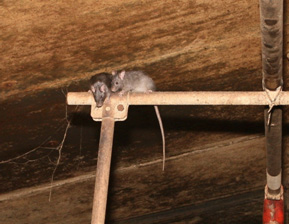Black rat
Appearance: The black rat has a blue-grey to black colour. The stomach is lighter to yellowy white. There are variations in colour (Alexandrian rat). The animal has a slender build with a pointy snout with large eyes and ears. The tail is noticeably longer (20 – 25 cm) than the body (15 – 23 cm). The weight of an adult rat is about 150 - 250 grams.
Lifestyle: Black rats are quite common. They are excellent climbers, which is why they are often found quite high up in buildings. They feed themselves on many kinds of products, with a preference for grain, seed and fruits.
The development into adulthood happens quite quickly; the females are fertile after about 3 months and can produce up to 10 litters in 2 years, each litter containing 6 – 10 young. The average lifespan is about 2 years.
General information: This kind of rat has lived in our country for many centuries (was the transmitter of the plague in the middle ages). It is most commonly found in buildings (including animal shelters and stables), as well as on board ships and in the harbor areas. They damage and contaminate stock
and material.
Defense: Through the use of architectural facilities, such as doors that shut properly, narrow ventilation openings, amongst others it is possible to keep rats out of the building. Also a good hygiene (storage and disposal of garbage, neat storage of products, periodically cleaning of the rooms, etc.)
is important in keeping rat free.
Combating: After a thorough inspection in and around the object bait boxes are placed in strategically chosen locations. In these bait boxes or crates, often placed in a location far above the ground, a poisonous bait is set. The rodent pesticide used (rodenticides),approved by the CTB, are so called anticoagulants (anti blood clotting substances) . These toxic substances are available as a ready to use bait or as fluid concentrates. By using these liquid concentrates the pest control technicians from Van Eck Industrial Hygiene BV are able to provide the most attractive bait, suitable for specific conditions. These baits have to remain for a number of weeks to be able to ensure death. After 4 to 10 days of consummation, death occurs after 7 to 14 days.
Recommendation: Using a preventive strategy, entailing a regular check of the grounds and stored goods, problems can be prevented. A point of interest
here is the object’s architectural and structural condition and the general hygiene.

(Rattus rattus L.)


